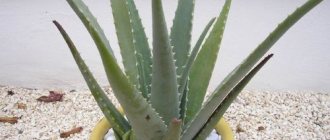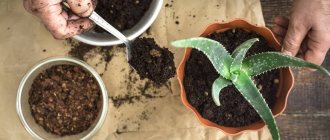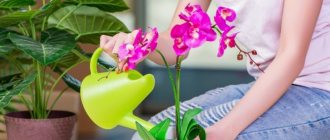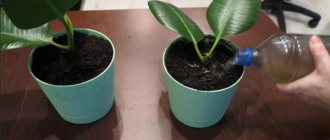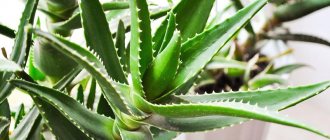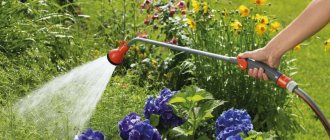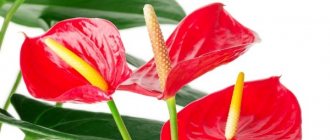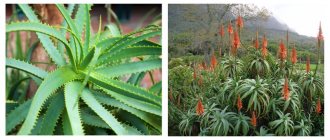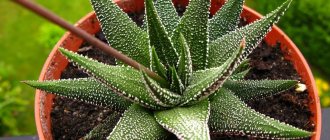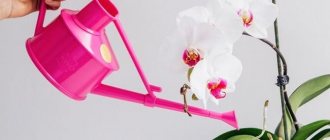Watering aloe - how to do it correctly so as not to destroy the plant
Aloe does not need frequent watering, since its leaves are able to accumulate and retain moisture. Excess water, as well as its lack, directly affect the health of the succulent. To avoid flower diseases, it is important to know how often you need to water aloe.
Aloe in a pot
The frequency of water procedures depends on several factors:
- season;
- air temperature and humidity;
- age of the succulent;
- degree of illumination of the house.
To determine whether an aloe needs watering, you need to dip your finger or toothpick into the pot to a depth of about four centimeters. If this layer of soil is dry, the plant needs water. The soil located higher evaporates moisture faster and is not an indicator of the moisture content of the plant’s root system.
Outdoor plants do not need additional watering on rainy days. In dry weather, moderate moisture will be needed, which is best done after sun exposure.
Further care
The following describes how to properly care for a transplanted plant.
- Immediately after transplantation, the aloe is removed to a shaded place for 1-2 weeks, even if it was previously in the sun. This must be done so that the plant adapts to new conditions and heals injured roots.
- The flower cannot be watered for the first 2-3 days due to injury to the root system. After the transplant, she is especially sensitive to infections.
- After the three-day period has passed, you can begin watering, but this must be done very carefully, avoiding water getting on the stem and leaves. Next, the plant is watered only when the top layer of soil dries 3-4 cm deep.
- The temperature regime for the transplanted flower must be maintained in the range of +20-25°C, since at lower temperatures there is a risk that the plant will be damaged by a fungal infection.
In which organs does a flower store moisture?
How to plant aloe correctly at home
This succulent is known for its ability to live without water for a long time. It will survive even if you dig it out of the ground and leave it in the air for several months.
The plant has long, fleshy leaves with small spines on the sides. Each leaf consists of pulp, which stores moisture, and a thick shell. It can retain water by closing its pores.
The cross-sectional photo of the leaf clearly shows the skin, which keeps the soft inner part of the leaf moist
How to water a plant
How to water Zamioculcas correctly so as not to destroy it
Depending on the age of the aloe, two watering methods are used:
- Young plants are moistened with preheated liquid through the bottom of the pot. To do this, you can put the aloe in a deep container with water or pour water directly into the tray. This method of watering is considered to be the most gentle, since when it is used, beneficial substances are not washed out of the soil.
- The soil with mature plants is watered generously from a watering can, avoiding getting it on the leaves - the accumulation of liquid in aloe rosettes can lead to rotting of the stem. To ensure that the soil absorbs all the moisture, it is first loosened. Do not direct the stream of water at the roots - this can expose them.
Important! Aloe should never be sprayed. This will not bring any benefit, but will only harm the flower - the leaves may get burned or begin to rot.
If dust accumulates, wipe the leaves with a damp cloth or cotton pad.
An hour after watering, you need to drain the remaining water from the pan.
Depending on the time of year
Each time of year has its own characteristics of watering agave.
After winter, the plant needs more moisture, which it needs to grow. In spring, it is watered once a week, and in summer the interval is reduced to twice a week.
In late autumn and winter, the bush requires almost no watering, as it is at rest.
How to water seeds
Propagation by seeds is a complex and not the most popular method of propagating aloe.
The germination process occurs as follows:
- The seeds are soaked in a weak solution of potassium permanganate and placed in a container with previously loosened soil, lightly pressing them into the surface. The distance between them should be about two centimeters.
- A small layer of sand is poured onto the ground.
- The container is lowered into a tray with warm water for some time.
- After moistening the soil, the container is transferred to a warm room. The soil must remain moist before the seeds sprout.
After the first shoots appear, the plant will need to be watered lightly once a week.
Watering shoots during propagation
The easiest way to propagate agave is by cuttings. After cutting aloe cuttings, they should not be placed in water. The shoots are sprinkled with wood ash and kept in air until roots appear.
Another option is to place them in a container of damp sand. This usually lasts several weeks. Afterwards they are placed in a pot with dry soil. At first, young shoots are not watered.
Transplanted aloe sprout
Important! The pot should have several holes at the bottom for water to drain after watering. A shallow tray is placed under the pot.
Choose a pot that is wide enough, otherwise the roots won't grow. The diameter of the pot should be approximately one half the length of the aloe leaf.
Watering during transplantation
Before transplanting aloe, it should not be watered for a month. The plant must be replanted into already moist soil. Watering for the first week after this is also not recommended.
The frequency of replanting a succulent depends on the age of the plant. Young aloe plants are planted once every two years, adults - every four years. It is recommended to do this in the spring. It is during this period that the agave is most ready for growth.
In nature, aloe grows in sand, but at home it is planted in soil consisting of sand, leaf soil and turf. The soil should be loose and soft. A layer of drainage is laid out at the bottom of the pot. For this, you can use any suitable material, for example, broken brick.
Preparing for transplant
New pots are rinsed with a solution of potassium permanganate, then with a solution of superphosphate. Old containers must first be washed with hot water to remove soil residues. Then it should be soaked in a solution of potassium permanganate for a day to prevent the development of diseases in plants. Already used drainage material is also treated.
The least hassle with soil preparation occurs when purchasing substrate for cacti and succulents at a flower shop or supermarket. Such soil is already ready for planting, the components are contained in the proportions required for a certain type of plant, and fertilizers are added. Add sand (2:1) to the universal substrate for indoor flowers. The disadvantage of this type of soil is the presence of peat (aloe does not like it).
You can prepare the soil for planting yourself. To do this, mix leaf, turf soil and sand in a ratio of 1:0.5:1. Crushed charcoal is added to the mixture. For rooting, it is better to plant cuttings in pots filled with coarse sand, washed in water and calcined in the oven.
Quality of water for irrigation, which one is better to use
Aloe should only be watered with soft water, the temperature of which should be several degrees higher than room temperature. In summer, the water is additionally heated. Too hard water forms a coating on the soil, and cold water can lead to rotting of the roots.
Is it possible to spray geraniums with water and how to water them correctly
There are several ways to prepare water for irrigation:
- Pour filtered or boiled water into a container and leave for a day.
- Freeze for several hours. Then let it sit for at least a day.
- Add a little citric or acetic acid (5 g per liter) to purified water.
- Use melted snow.
Important! Do not use tap water. It may contain substances harmful to the plant, such as chlorine and alkalis.
The process of watering agave
Different possible ways
Transplant adult plants with roots into a larger pot if there is not enough room for roots in the old one. One variant of this method is called transshipment. As with replanting, use a container 2–3 cm larger in diameter than the old one and fill the empty space with fresh soil. The earthen lump is taken out of the pot in the same way as when transplanting, without clearing the soil.
Attention! Transfer to a smaller container if a significant portion of the leaves have been cut off.
Without roots, the tops and side shoots 15–20 cm long are transplanted. An adult plant forms many layerings - “babies”. Young shoots are separated from the mother plant with a sharp knife. The cuttings should be healthy and have 5–6 leaves.
The cut site is treated with crushed charcoal for disinfection. Then leave the cuttings in a well-ventilated place for 6–8 days. At the site of a withered cut, roots grow better and rotting occurs less frequently. Aloe planting material does not lose its viability for a long time without water and soil.
Advice. Dried cuttings are best rooted in washed sand. Deepen the lower part of the plant by about 2 cm and press it to the substrate.
In addition to vegetative propagation, seed propagation of aloe is practiced. Seeds are sown in a room greenhouse and embedded shallowly in the substrate. Regularly moisten the soil with a spray bottle. Germinate at a temperature of 19–21°C. Seedlings that have developed leaves are transplanted into separate containers (as described above).
The combination of watering and applying liquid fertilizer during cultivation
Fertilizing for home succulents can be done along with watering: it is better to use fertilizers during or after watering. Such procedures are carried out only during the period of active growth of aloe - from March to September, and no more than three to four times per season.
Rich soil is fertilized only once. Excess feeding can cause root burns. Humic fertilizers, potassium phosphate and special ready-made mixtures marked “for succulents” are used as fertilizers.
In some cases, aloe cannot be fed:
- young plants up to three years old;
- sick or infected with parasites;
- victims of sun rays or lack of moisture;
- plants that will be used for cosmetic or medicinal purposes.
Interesting! Diluted aloe juice can be used as a natural supplement. Another popular “folk” recipe is sweet sugar water. To prepare it, dissolve one tablespoon of sugar in a glass of water.
What happens if you do not comply with the conditions for keeping aloe
Caring for homemade aloe consists of properly maintaining the level of heat, moisture and light. Under natural conditions, this succulent grows in hot and arid climates, so it is demanding on the level of air humidity. If the plant is very dry, the stems may become wrinkled; it is recommended to wipe them with a damp cloth.
The aloe pot should be in a warm, well-lit place. Window sills on the south side are best suited. In summer, agave prefers a temperature of about 25 degrees Celsius. On days when there is no rain, aloe can be taken out into the open air. In winter, the room temperature is reduced by 5-10 degrees.
If the above conditions are not observed, the houseplant will begin to wither. In addition, improper care weakens the living organism. As a result, any attacks by pests or pathogens lead to more severe consequences. In the most advanced cases, the flower dies.
Aloe outdoors
Varieties and types
Due to the presence of the above unique properties in this plant, it is not surprising that aloe is often called a home doctor and people try to grow it on their windowsill. Several species of this representative of the flora are the most popular among gardeners.
Different types of aloe
Table. Common types of indoor aloe.
| View, photo | Description |
| Aloe vera | The same species that immediately comes to mind when the word “aloe” is mentioned. Also called real, Indian, Barbaden. This is the most common aloe among all others and it is the one most often found in gardeners’ collections. Vera has elongated lanceolate fleshy leaves, evenly covered along the edges with small spines-teeth. A short stem formed from the bases of leaf blades tightly adjacent to each other, which can be about 50 cm long. In the wild, aloe vera grows in the Mediterranean Sea region, and is also found in areas with a critically hot climate. |
| Aloe arborescens | This species is also often found in gardeners’ collections; its second name is agave. It appeared due to a common myth that this species supposedly blooms only once every 100 years. In fact, in the wild, agave blooms every year, but in apartments this phenomenon really happens rarely. The plant can reach 3 m in height. Agave's homeland is Africa, where it is found almost everywhere, and is not bothered by the hot and arid climate. Tree aloe is a shrub with a fibrous root system. It has succulent concave leaves, which are very often used to prepare medicinal home remedies, are up to 25 cm long, and also have sharp teeth along the edges. The stem of the plant is well defined. |
| Variegated aloe | This species is also called tiger. Its representatives are low plants (up to 40 cm) with a short stem covered with white-striped leaves. The plant itself is very beautiful. |
| spinous aloe | A rare, but very beautiful guest in the collections of flower growers. Its main difference from other aloe is the presence of white hairs at the tips of the leaves, which dry out and fall off as it grows. There is no stem, and the leaves are quite prickly to the touch. Often the plant develops “babies” that do not interfere with the growth and development of an adult representative of the species. |
All these types of aloe have the above beneficial properties, for which they are valued by fans of traditional medicine and lovers of home floriculture. And each of the plants, despite its unpretentiousness, needs proper care.
The main mistakes gardeners make when watering
If we talk about aloe, watering is one of the most important components of proper care. Almost all diseases of medicinal plants occur due to violation of watering rules. By neglecting them, the owner of the flower runs the risk of completely ruining the plant.
You should consider the most common mistakes novice gardeners make when watering aloe:
- A plant covered with yellow-brown spots means that a large amount of water has gotten on the leaves due to inaccurate watering or spraying.
- Leaves broken at the base of the stem indicate its rotting. This occurs due to the accumulation of water on the aloe leaves.
- Thin, drooping leaves indicate a lack of moisture.
- A light rusty coating on the soil, blackened weak stems and an unpleasant, mushroom smell are a symptom of the appearance of bacteria and fungi in the root system. Due to the accumulation of water in the soil, the roots began to rot.
- If you use insufficiently warm water, the aloe will shed its leaves.
If the roots of the plant have just begun to rot, it can still be saved. To do this, aloe is removed from the soil, washed and dried. Rotten parts of the roots are removed. After the plant dries, it is placed in new soil with a high sand content. The old soil must be destroyed and the pot disinfected. After a week, the plant can be watered and fed.
It is important to monitor the condition of the plant daily. Any changes in the smell or appearance of a flower or its soil may indicate serious problems.
This unpretentious succulent is not at all difficult to care for. In order for the agave to grow healthy and beautiful, all necessary features should be taken into account when watering. Knowing how to water aloe at home, you can avoid common mistakes.
